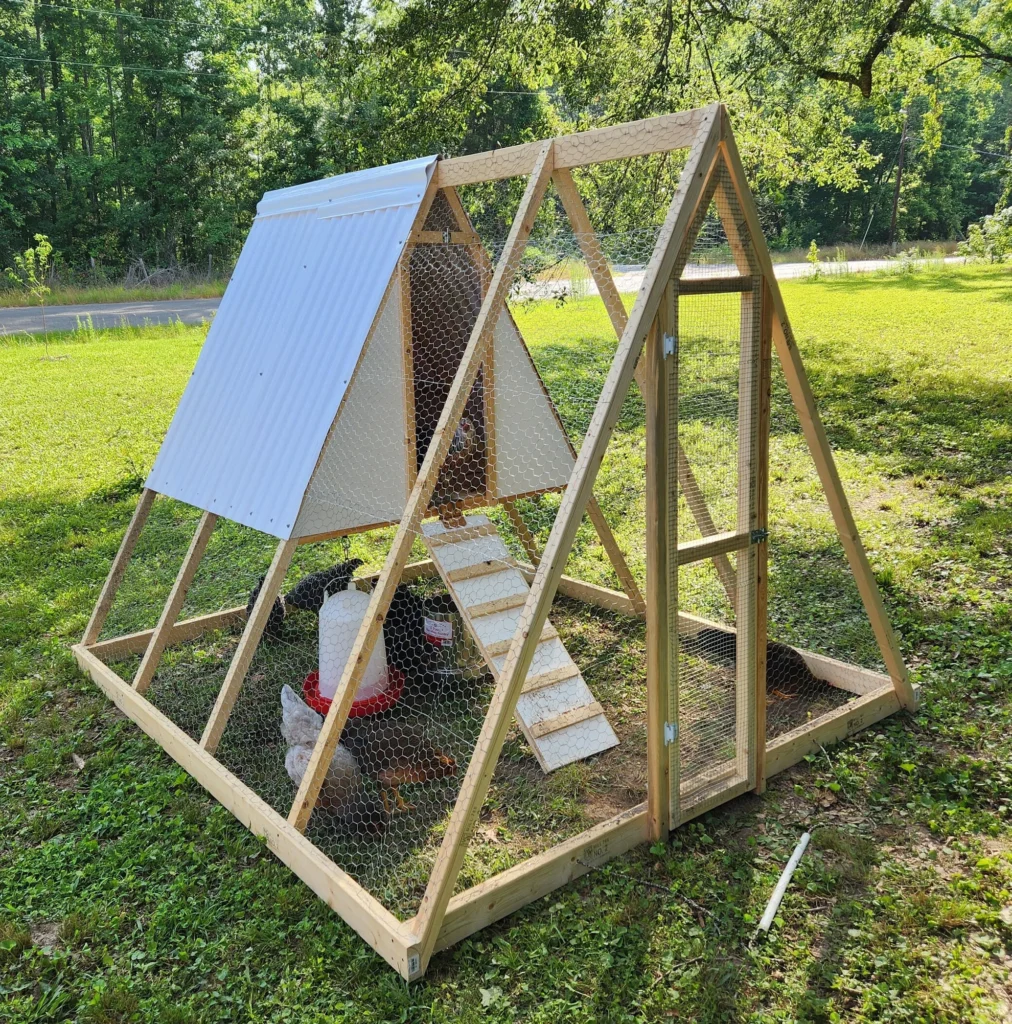I’ll be honest right up front when I first heard about an A frame chicken tractor, I thought, “heck yeah, that’s just a fancy triangle coop on wheels, how hard can it be?” Well, lemme tell you, I’ve built a few now, and I’ve made about every mistake a guy can make. Crooked cuts, too heavy to push, chickens escaping like little feathered Houdinis you name it. But after ten years messing around with homesteading in my backyard, I finally got a system that works, and I wanna share the real dirt with you, not the Pinterest-perfect version.
Why I Even Wanted an A Frame Chicken Tractor
So picture this: I was hauling buckets of water out to the coop one morning, and my wife yells, “The yard stinks!” Yep, chickens in one place too long will tear up grass, poop everywhere, and smell like a bad summer fairground. I wanted a way to move the birds around the yard so they could eat bugs, fertilize, and not destroy one single patch of ground. That’s the whole idea of a chicken tractor. The A frame design caught my eye because it looked simple, strong, and light enough (in theory) to drag around by myself.
My First Attempt (AKA the Chicken Jailbreak of 2014)
The first one I built was from scrap lumber and chicken wire I had laying around. It looked more like a drunk teepee than a proper tractor. I figured, hey, chickens aren’t picky. But the next morning, I woke up to my neighbor’s kid yelling, “Dad! There’s chickens in the driveway!” My hens had slipped right under the edge because I didn’t secure the wire tight enough. Lesson learned: if there’s even a two-inch gap, chickens WILL find it.
And moving that beast? Forget it. I didn’t think about weight, so dragging it across the lawn felt like towing a tractor with a bicycle.

How I Finally Got It Right
After that disaster, I started treating it more like a real build. Here’s what worked for me:
- Frame with 2x4s, but don’t overbuild If you use heavy lumber everywhere, it’ll weigh a ton. I mix 2x4s for strength and lighter 1x3s in spots that don’t need much.
- Hardware cloth, not chicken wire Chicken wire keeps chickens in but doesn’t keep raccoons out. Hardware cloth is tougher and worth every penny.
- Add handles or wheels Trust me, your back will thank you. I bolted old lawnmower wheels on mine.
- Simple roof I slapped on some tin roofing I found cheap. Keeps the rain off and lasts forever.
- Anchor it in wind One storm taught me real quick, an A frame can act like a sail. Now I pound in rebar stakes at night.
Daily Life With the A Frame Tractor
These days, moving the tractor is part of my morning routine. Feed the chickens, check the garden, drag the A frame to a fresh patch of grass. The birds go nuts for the new bugs and greens. My lawn looks like a patchwork quilt, but honestly, I kinda like it. Each square gets fertilized, then it grows back stronger.
One funny thing our dog used to go crazy chasing the hens. Now he just walks alongside the tractor like he’s guarding them. Who knew?
The Good, The Bad, and the Ugly
Good:
- Fresh grass and bugs for the hens.
- No one patch of the yard gets ruined.
- Way less stink.
- Eggs taste better (or maybe it’s just in my head).
Bad:
- Heavy if you build it wrong.
- Wind can flip it.
- Chickens sometimes peck each other more in close quarters.
Ugly:
- Don’t use old rusty nails. I did once, and sliced my hand open. Felt dumb showing up at urgent care saying, “I cut myself on my chicken tractor.”
Mini FAQ From a Guy Who Screwed Up
Q: How many chickens can fit in an A frame chicken tractor?
A: Depends on size. My 8-foot tractor holds 4 hens comfortably. I tried 6 once, and they looked miserable. Don’t crowd them.
Q: Do I need wheels?
A: Yes. Unless you enjoy back pain. Even cheap lawnmower wheels make a world of difference.
Q: Can I use it year-round?
A: Sorta. Works great spring through fall. Winter? Not unless you live somewhere warm. Mine gets parked in the shed once snow hits.
The Time I Got Too Fancy (And Regretted It)
One year, I thought I’d be clever and add nesting boxes and a little door so I could collect eggs without opening the whole tractor. Sounds smart, right? Well, I overcomplicated it. Hinges broke, the door warped, and rain leaked right onto the bedding. Sometimes simple is better. My current tractor is just a dry spot under the roof and roosting bars. Works fine.
Tips I’d Give My Best Friend
- Start small. Build a short 6 foot one before going huge.
- Don’t cheap out on hardware cloth.
- Make it light you’ll move it more than you think.
- Expect your first try to be kinda ugly. Mine sure was.
- Don’t stress about perfection. Chickens don’t care if it’s square.
Lessons From My Backyard
The coolest part of an A frame chicken tractor? Watching the cycle. Chickens eat weeds, grass, and bugs. They poop it out. A week later, the spot is greener than before. It’s like a little permaculture loop right in the yard. I even park the tractor in my garden beds in early spring to let the birds clean up weeds and fertilize before I plant.
One mistake I made: leaving the tractor too long in one spot. They’ll scratch it bare and leave a mud pit. Now I move mine every day or two. It’s a rhythm, like feeding the sourdough starter or turning the compost.
Would I Do It Again?
Absolutely. An A frame chicken tractor isn’t perfect, but it’s one of those homesteading projects that actually makes daily life easier. Plus, there’s something fun about watching chickens act like chickens scratching, pecking, dust bathing in fresh grass. Beats seeing them bored in a stationary coop.
So if you’re thinking about building one, go for it. Just know you’ll probably mess up the first time, and that’s fine. I sure did. But once you get it dialed in, it’s a game changer.
Got a weird question about chicken tractors? Drop it in the comments I actually answer. And if you end up slicing your hand on a rusty nail, at least you’ll know you’re not the only one.

